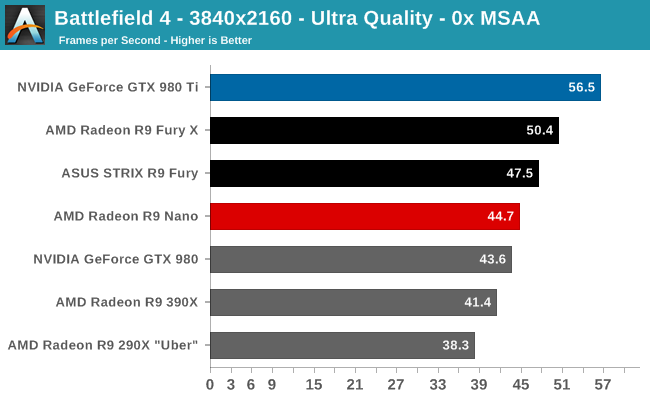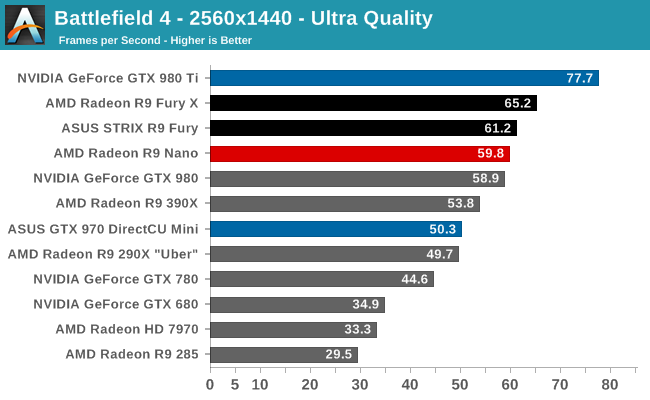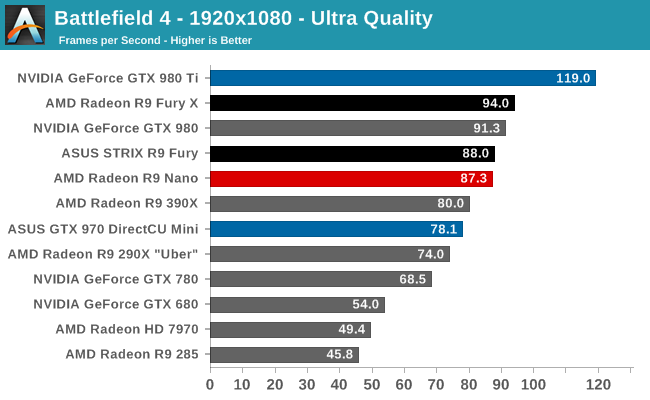The AMD Radeon R9 Nano Review: The Power of Size
by Ryan Smith on September 10, 2015 8:00 AM ESTBattlefield 4
Kicking off our benchmark suite is Battlefield 4, DICE’s 2013 multiplayer military shooter. After a rocky start, Battlefield 4 has since become a challenging game in its own right and a showcase title for low-level graphics APIs. As these benchmarks are from single player mode, based on our experiences our rule of thumb here is that multiplayer framerates will dip to half our single player framerates, which means a card needs to be able to average at least 60fps if it’s to be able to hold up in multiplayer.




Like the other Fiji cards, AMD is promoting the R9 Nano in part on its 4K capabilities. And while we disagree that this card is suitable for 4K gaming based on its sub-Fury performance, we’re including 4K results anyhow to serve as a point of comparison.
In any case Battlefield 4 is often a good indicator of general card performance, and for the R9 Nano this is no exception. What we find is that the R9 Nano trails the other Fury cards in all cases. However to our initial surprise, the R9 Nano sticks rather close to the R9 Fury. The petite powerhouse trails the R9 Fury by only 1-6%, which for the record is a smaller gap than we were expecting.
While the R9 Nano packs a full Fiji GPU, AMD has to pull back on clockspeeds to hit their power targets; in the case of Battlefield 4 this is an average clockspeed of just 879MHz at 2560x1440. Given this we had been expecting the R9 Nano to deliver around 85-90% of the performance of the R9 Fury (and about 80% of the R9 Fury X), based on the assumption that average clockspeeds would be closer to 800MHz. So the fact that the R9 Nano starts off as close to the R9 Fury as it does – even if it’s still trailing it – is a pleasant surprise.
Otherwise with performance still clearly occupying a position as a “3rd tier” Fiji card, I’m not sure if anything about these results should be surprising. On a price/performance basis AMD is not intending to be competitive with other $650 cards, so the R9 Fury X and GTX 980 Ti are of course on the top of the heap. What you get instead is a card that delivers around 90% of R9 Fury X’s performance in BF4 with much less power consumption.
Moving on, compared to the lower power and smaller cards, the R9 Nano is as expected a clean sweep. Demonstrating the virtues of a wide and lower clocked processor’s ability to deliver strong performance without requiring extreme power, everything from the R9 285 to the GTX 980 trails the R9 Nano here. Compared to the GTX 970 Mini in particular, the R9 Nano is 12-26% faster depending on the resolution.
The one potential problem here for the R9 Nano is the GTX 980. Though not a Mini-ITX card, the GTX 980’s power consumption is going to be fairly close to the R9 Nano’s, definitely more so than GTX 970’s. From a power efficiency standpoint it’s the GTX 980 that poses the greatest challenge to the R9 Nano, and while it’s ahead of the GTX 980 in this case at 2560x1440 and higher, it’s a sign that AMD should be worried about what could happen if an NVIDIA partner produced a Mini-ITX GTX 980.










284 Comments
View All Comments
jay401 - Friday, September 11, 2015 - link
The only thing wrong with the Nano and the rest of the Fury lineup is the price. They should all have debuted $50 cheaper than they did.theNiZer - Thursday, September 10, 2015 - link
My thoughts exactly :)HisDivineOrder - Thursday, September 10, 2015 - link
Nice to see that Anandtech didn't mind getting their card with whatever promises they had to make to get it. I'm reminded of the AMD Red section that this site once had and I begin to wonder if that payment scheme ever really ended or just went "underground?"garbagedisposal - Thursday, September 10, 2015 - link
Jesus Christ, you are one especially rabid and unpleasant person. Please don't comment on this website.Oxford Guy - Thursday, September 10, 2015 - link
If you think this site is pro-AMD you clearly don't read the reviews, like the review of Broadwell that included like 8 slow APUs and not a single FX chip at a reasonable clockspeed (like 4.5 GHz), even though FX, not APUs, offers the best desktop performance from AMD.Creig - Thursday, September 10, 2015 - link
Looks like we have a new generation of Wounded [H] Children on our hands.Will Robinson - Thursday, September 10, 2015 - link
Seeing that Tech Report's Graphics forum used to be sponsored by Nvidia....I guess it went to the same place hmm?eanazag - Tuesday, September 22, 2015 - link
I want one, but not at that price. They need a version of the nano at $300-50 that smacks the 970 mini from cheek to cheek. Though with the whole Fiji series I am disappointed it maxes out at 4 GB of VRAM.Anyhow, I would be interested in the best performance a vendor could offer in a single slot cooler. Not the usual duds that come with a single slot cooler. Ooorrrrr okay performance with a water cooler, when I say okay performance I'm thinking what usually comes in at the $180+-$225 price range.
colonelclaw - Thursday, September 10, 2015 - link
As someone who is currently heavily invested in Nvidia tech, I would just like to say well done to AMD, this a great (little) product!980 nano please :)
nathanddrews - Thursday, September 10, 2015 - link
Probably not a 980 Nano, but a 1080 Nano is more likely. This is the future of GPUs. Next year we get FinFET and HBM2 from NVIDIA and ATI. It's only a matter of time before both AMD and NVIDIA have full lineups of SFF GPUs. Why pay more for all that PCB space if you don't need it?